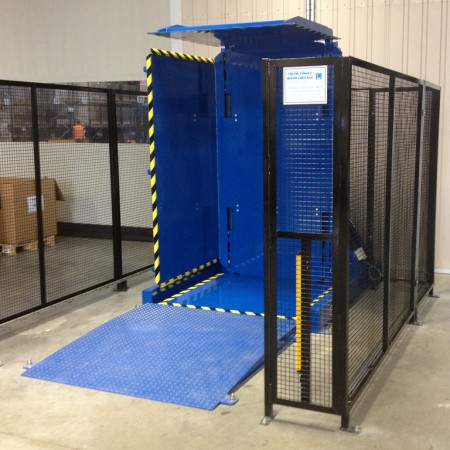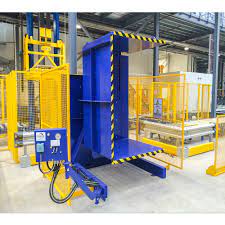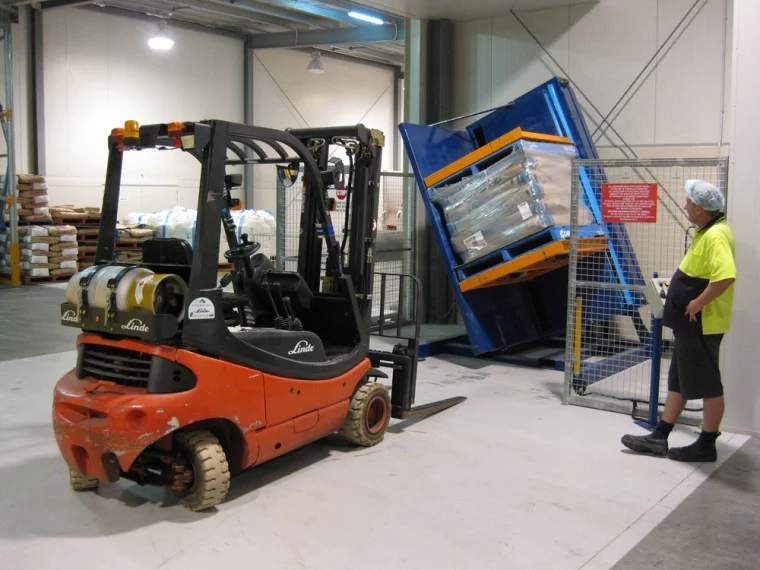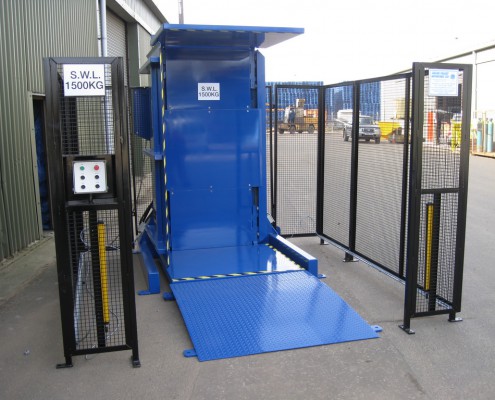Cutting Downtime in Brazil: How Pallet Changing Machines Help
In the fast-paced world of Brazilian manufacturing, every minute counts. A single, unexpected stoppage on your production line can create a ripple effect of delays, missed deadlines, and rising costs. Often, the cause is something as simple as a broken or non-standard pallet. This small problem can quickly become a major headache, forcing your team into slow, unsafe manual labor to transfer heavy goods. It's a frustrating bottleneck that directly impacts your bottom line. But what if you could solve this problem in minutes, not hours, without anyone ever lifting a single box? This is where a pallet changing machine becomes a game-changer for your entire operation.
Pallet changing machines help cut downtime in Brazil by providing a fast, automated, and safe method for transferring goods from a damaged or incorrect pallet to a new one. Instead of relying on manual labor, which is slow and risks product damage or worker injury, these machines can securely grip and invert a full load, allowing for a pallet swap in under a minute. This turns a potential multi-hour production halt into a brief, controlled process, keeping your main production lines running and maintaining overall plant efficiency.

This solution might seem straightforward, but its impact is profound. I've seen it firsthand. I remember visiting a steel processing plant in Minas Gerais. They were incredibly efficient with their main production, but their end-of-line packaging was a constant source of trouble. A cracked wooden pallet could stop their wrapping machine for over an hour. Seeing their frustration reminded me of my early days as an engineer. I learned then that a factory is only as strong as its weakest link. For them, the weak link was the pallet. It's a common story in Brazil and across Latin America. Let’s explore how investing in this one piece of equipment can create widespread improvements across your factory floor.
What specific downtime risks does a pallet changer eliminate in a steel plant?
Imagine a heavy coil of steel, perfectly wrapped and ready for shipment, sitting on a pallet. Suddenly, an operator notices a crack in a pallet board. The entire line stops. Your team now faces the dangerous and time-consuming task of manually de-stacking the product, replacing the pallet, and re-stacking everything. This single event introduces multiple risks: safety hazards for your workers, potential damage to the finished product, and significant, unplanned downtime. This is a recurring nightmare for plant managers. A pallet changer is designed to make this scenario a thing of the past, directly addressing these critical operational risks.
A pallet changer in a steel plant specifically eliminates downtime caused by pallet-related issues. It removes the need for manual repalletizing when a damaged, low-quality, or incorrect-spec pallet enters the logistics chain. By automating the transfer process, it bypasses the safety risks and time loss associated with manual handling of heavy or unstable loads like steel wire or stacked plates. This ensures that a simple pallet fault does not escalate into a major production stoppage, protecting both your assets and your schedule.

Let's dive deeper into the specific risks and how a pallet changer mitigates them. In an environment like a steel mill, where loads are heavy and products are high-value, these risks are amplified.
The Problem of Inbound Pallets
Many factories have no control over the quality of pallets that come from their suppliers. A shipment might arrive on a cheap, single-use pallet that is not strong enough for internal transfer systems or for the final customer. Without a pallet changer, your team has two bad options. They can either risk using the weak pallet, hoping it doesn't break and cause a bigger problem later. Or, they can stop the receiving process to manually transfer the goods. This creates a bottleneck at the very start of your internal process. A pallet changer, placed at the receiving dock, solves this immediately. It allows you to standardize all internal pallets, transferring incoming goods to high-quality, in-house pallets right away.
Mitigating Safety and Ergonomic Hazards
Manual handling of heavy steel products is inherently dangerous. A CEO like Javier Morales knows that worker safety is not just a regulatory requirement; it's a moral and financial imperative. Manually transferring steel coils or stacked sheets puts workers at risk of back injuries, strains, and crush injuries. The process is slow because it has to be done carefully. A pallet changer removes the human from this hazardous equation. The machine does all the heavy lifting and tilting. This not only eliminates a major category of workplace accidents but also boosts morale. Workers can be reassigned to more valuable, less physically demanding tasks.
Protecting Product Quality
During a manual pallet swap, the product itself is at risk. A forklift might clip the edge of a steel sheet. A coil might be scuffed or dented when it's set down. These minor damages can lead to customer rejection, requiring costly rework or scrapping of the product. The gentle, controlled clamping and rotation of a pallet inverter ensures the product is never compromised. It holds the stack securely in place while the pallet is exchanged. For a business that prides itself on quality, this is a crucial benefit. It protects your revenue and your reputation.
| Risk Factor | Manual Pallet Swap | With Pallet Changer |
|---|---|---|
| Downtime per Incident | 30 - 90 minutes | 1 - 2 minutes |
| Labor Requirement | 2 - 4 workers | 1 operator |
| Worker Safety Risk | High (strains, crush injuries) | Minimal (automated process) |
| Product Damage Risk | Moderate to High (scuffs, dents) | Minimal (secure clamping) |
| Operational Bottleneck | High (stops line, receiving) | Low (isolated, quick procedure) |
How does a pallet changer impact overall operational costs beyond just uptime?
When a plant owner considers new equipment, the first question is always about the return on investment. The link between a pallet changer and reduced downtime is clear. But a truly strategic investment, like the ones Javier Morales champions, delivers value across multiple areas of the business. The financial benefits of a pallet changer extend far beyond simply keeping the production line moving. It creates a cascade of cost savings that can significantly reduce your overall operational expenditure, directly contributing to the goal of lowering costs by 8% or more.
A pallet changer impacts operational costs by reducing labor expenses, minimizing product waste, lowering insurance and compensation claims, and optimizing your pallet inventory. By automating a manual task, you free up valuable manpower. By preventing damage, you cut costs associated with rework and scrap. A safer work environment leads to fewer accidents and lower insurance premiums. You can also implement a pallet management strategy, using high-quality internal pallets and cheaper ones for shipping, saving money on pallet purchasing.

Let's break down these cost-saving areas. I always advise my clients to look at the total picture. When you buy a machine from SHJLPACK, you're not just buying steel and motors; you're buying a solution that should make your entire business healthier.
Direct Labor Cost Reduction
Think about the labor involved in a manual swap. You might need two, three, or even four workers to safely move a heavy load. You are paying their wages for them to perform a low-value, repetitive task. Let's say a manual swap takes 45 minutes for a team of three. With a pallet changer, one operator can complete the same task in two minutes. The saved man-hours can be reallocated to quality control, machine maintenance, or other activities that add real value to your product. This is a direct and easily measurable labor cost saving that repeats with every pallet swap.
Decreased Product Loss and Rework
In the steel industry, products are valuable. Even a small amount of damage can be costly. A scratch on a coated steel coil could make it unusable for an automotive client. A dented stack of metal sheets might be rejected by a construction project. Manual handling introduces a high risk of this kind of damage. Every time a product is moved by hand, there is a chance it gets dropped, scraped, or mishandled. A pallet changer holds the product stack in a firm, secure block, eliminating this risk. Reducing your scrap rate by even a fraction of a percent can add up to significant savings over the course of a year.
Lower Costs Associated with Workplace Injuries
Workplace safety is a major concern for any industrial leader. Accidents are tragic for the individuals involved, and they are also expensive for the company. There are direct costs, like medical bills and workers' compensation, and indirect costs, like lost productivity, administrative time for incident reporting, and potential increases in insurance premiums. Back and strain injuries from manual lifting are among the most common and costly workplace accidents. By automating this task, a pallet changer is a powerful tool for risk management, directly lowering the chance of these expensive incidents. I have seen clients whose insurance partners even recognized this investment with better rates.
Optimization of Pallet Inventory
Pallets themselves are a cost center. High-quality, durable pallets are expensive. Cheaper, one-way shipping pallets are less so. A pallet changer allows you to implement a two-tier pallet strategy. You can invest in a fleet of robust, long-lasting pallets for all internal movements within your plant. When a product is ready to be shipped, you can use the pallet changer to quickly transfer it to a cheaper shipping pallet. This protects your expensive pallet assets from being lost or damaged once they leave your facility. Over time, the savings from not having to constantly replace high-end pallets can be substantial.
Which type of pallet changer is right for heavy-duty industrial loads like steel coils?
Choosing the right equipment is critical. A machine that works perfectly for a food and beverage company might be completely inadequate for the demands of a Brazilian steel plant. The weight, dimensions, and stability of the load are key factors. For heavy, dense, and potentially unstable loads like steel coils or wire, you cannot compromise on strength and reliability. Selecting the wrong machine is not just a waste of capital; it's a safety risk and a future maintenance problem.
For heavy-duty industrial loads like steel coils, the most suitable machine is typically a 180-degree pallet inverter. This type of machine clamps the load securely from both the top and the side before rotating it a full 180 degrees. This process ensures that even cylindrical or irregularly stacked products are held firmly in place throughout the transfer. Standard pallet exchangers that push the load from one pallet to another may not be suitable, as they can cause heavy loads to shift, become unstable, or get damaged.

When I work with clients in heavy industries, like my friends in the steel sector, my first goal is to understand the product. It’s not about selling a specific model; it's about finding the perfect fit. Let's look at the options and why the inverter is usually the best choice for this application.
Understanding the Machine Types
There are several styles of pallet changers, but they generally fall into a few categories:
- Pallet Inverters: These machines clamp the load, turn it upside down (180 degrees), allow the old pallet to be removed from the top, and then a new pallet is placed before turning it back. This is the most secure method for heavy or unstable goods.
- Pallet Exchangers (Push-Pull): These machines hold the load in place and push it horizontally from one pallet to another. This is great for solid, stable, boxed goods but can be risky for loads like coils that might roll or shift.
- Tilters: These machines tilt the load to about 90 or 110 degrees, allowing the pallet to be exchanged. They are a good middle ground but may not provide the same level of security as a full inverter for very heavy loads.
Why the 180-Degree Inverter Excels for Steel
For products like steel coils, wire spools, or even stacks of polished metal plates, stability is the primary concern.
- Total Load Control: The inverter's clamping mechanism provides pressure from multiple sides. This contains the entire load as a single, solid block. There is no opportunity for individual items to shift, slide, or fall.
- Handling of Unconventional Shapes: A steel coil is cylindrical. A push-pull system would struggle to move it without it rolling. The inverter simply turns the whole package over, keeping the coil's orientation and stability intact.
- Heavy-Duty Construction: Machines designed for the steel industry must be robust. Pallet inverters built for these applications feature reinforced steel frames, powerful hydraulic or electric motors, and heavy-duty clamping pads designed to handle loads of 2,000 kg or more without issue.
Key Features to Look For
When advising a client like Javier, I would point out specific features that are non-negotiable for a steel plant application:
- Adjustable Clamping Pressure: You need enough pressure to hold the load securely, but not so much that you damage the product. A machine with adjustable pressure is essential.
- Loading Method: Can it be loaded with a forklift or does it need to be loaded at ground level with a pallet truck? The machine must fit your existing workflow. Models with a loading ramp or that lower to the floor are more flexible.
- Control System: Modern machines should have simple, intuitive controls. A push-button or joystick interface is standard. For integration into a smart factory, PLC controls that can communicate with a central MES are a must.
| Machine Type | Best For | Pros | Cons for Steel Industry |
|---|---|---|---|
| 180° Inverter | Heavy, unstable, or round loads (steel coils, barrels) | Maximum security, handles any shape, robust | Larger footprint, slightly slower cycle |
| Push-Pull Exchanger | Boxed, stable, square loads (e.g., consumer goods) | Fast cycle time, smaller footprint | High risk of shifting/damaging coils or stacks |
| 90° Tilter | Sacks, bags, semi-stable loads | Good balance of speed and security | May not be secure enough for very heavy, top-heavy loads |
How can pallet changers be integrated into a modern, digitized factory floor?
A forward-thinking leader like Javier Morales isn't just solving today's problems; he's building the factory of the future. His goal to deploy MES, IoT sensors, and big data is a clear sign that he understands the power of information. In this context, a machine is no longer just a standalone piece of equipment. It must be a connected, intelligent node in a larger digital ecosystem. A pallet changer, therefore, must do more than just swap pallets. It needs to be able to communicate, report data, and fit seamlessly into an automated, data-driven workflow.
Pallet changers can be integrated into a modern, digitized factory floor by equipping them with PLC (Programmable Logic Controller) systems that can interface with a plant's MES (Manufacturing Execution System). This allows the machine to receive automated commands, for example, from a robotic AGV (Automated Guided Vehicle). It can also send back data on cycle times, number of operations, and fault codes. By adding IoT sensors, you can monitor motor temperature, hydraulic pressure, and other key metrics for predictive maintenance, aligning perfectly with a goal of 95% uptime.

This integration is where my passion for engineering and system design really comes alive. It's about making the machines talk to each other to create a truly seamless and intelligent operation. Here’s how we make it happen.
The PLC as the Brain
The foundation of integration is the PLC. A basic pallet changer might have simple push-button controls. An intelligent one has a PLC that can be programmed for complex logic. This PLC is the machine's brain. It can be connected to the factory network via standard industrial protocols like EtherNet/IP or PROFINET.
- Receiving Commands: Your MES or WMS (Warehouse Management System) can send a command to the pallet changer. For instance, when a pallet with a specific ID arrives, the system knows it's an external pallet that needs to be swapped. It automatically tells the pallet changer to run its cycle once the pallet is in place.
- Sending Data: After each cycle, the PLC can send a confirmation message back to the MES. This creates a digital record of every pallet swap, providing valuable data for traceability and quality control.
Integration with Robotics and AGVs
In a fully automated factory, there are no human forklift drivers. AGVs or robotic arms transport goods. A smart pallet changer must be able to work with them.
- Automated Loading/Unloading: We design safety zones and communication handshakes. An AGV carrying a pallet will report its arrival to the pallet changer. The machine's safety sensors confirm it's in the correct position. The AGV backs away, the machine runs its cycle, and then signals the AGV to come and pick up the load on the new pallet. This creates a fully autonomous "pit stop" for your products.
Predictive Maintenance with IoT
One of Javier's key goals is predictive maintenance to boost uptime to 95%. This is a perfect application for IoT sensors on a pallet changer.
- Monitoring Key Components: We can place sensors on the hydraulic power pack to monitor oil temperature and pressure. We can add vibration sensors to the main rotation motor.
- Data Analysis: This data is streamed to a central platform. An algorithm can learn the machine's normal operating parameters. If the motor vibration starts to increase over several weeks, it's a sign that a bearing might be wearing out. The system can automatically generate a maintenance work order to replace the bearing during the next planned shutdown, long before it fails unexpectedly. This is the essence of predictive maintenance: fixing problems before they stop your production.
This level of integration transforms the pallet changer from a simple tool into a strategic asset for achieving digitalization and operational excellence.
My Insights: A Pallet Changer is More Than a Machine, It's a Philosophy
I've spent my life in and around packing machines. I started on the factory floor, just like many of your team members. I learned how things work by getting my hands dirty. Later, when I built my own factory, SHJLPACK, I had to think like an owner. I had to worry about costs, efficiency, and my clients' success. This journey from engineer to owner taught me a crucial lesson: the most successful leaders don't just buy equipment, they invest in a better way of operating.
A pallet changer is a perfect example of this. On the surface, it's a machine that swaps pallets. But in reality, it represents a shift in thinking. It’s a move from being reactive to being proactive. A reactive manager waits for a broken pallet to stop the line, then scrambles to fix it. A proactive leader anticipates the problem of bad pallets and installs a system to handle it seamlessly before it ever causes a stoppage. This is the same forward-thinking mindset that leads someone like Javier Morales to install a waste heat recovery system. He's not just fixing a problem; he's optimizing the entire system by finding value in a support process.
Investing in a machine like this sends a powerful message to your entire organization. It says that you value your workers' safety by automating a dangerous job. It says you respect your customers' quality standards by protecting the product from damage. And it says that you are serious about efficiency, not just on the main production line, but in every corner of the factory.
From my experience helping clients across Brazil and the world, I can tell you that the greatest gains in efficiency often come from these overlooked areas. Everyone focuses on making the main furnace or rolling mill faster. But the real, untapped potential is often in the logistics, the packaging, the small steps that connect the major processes. By solving these smaller problems, you create a smoother, more resilient, and more profitable operation overall. This is the philosophy we build into every machine at SHJLPACK. We're not just selling you a total solution for wrapping; we're offering a partnership in building a stronger business.
Conclusion
Ultimately, a pallet changing machine is a strategic tool. It directly cuts downtime, reduces costs, improves safety, and integrates seamlessly into the modern, data-driven factories being built across Brazil.




